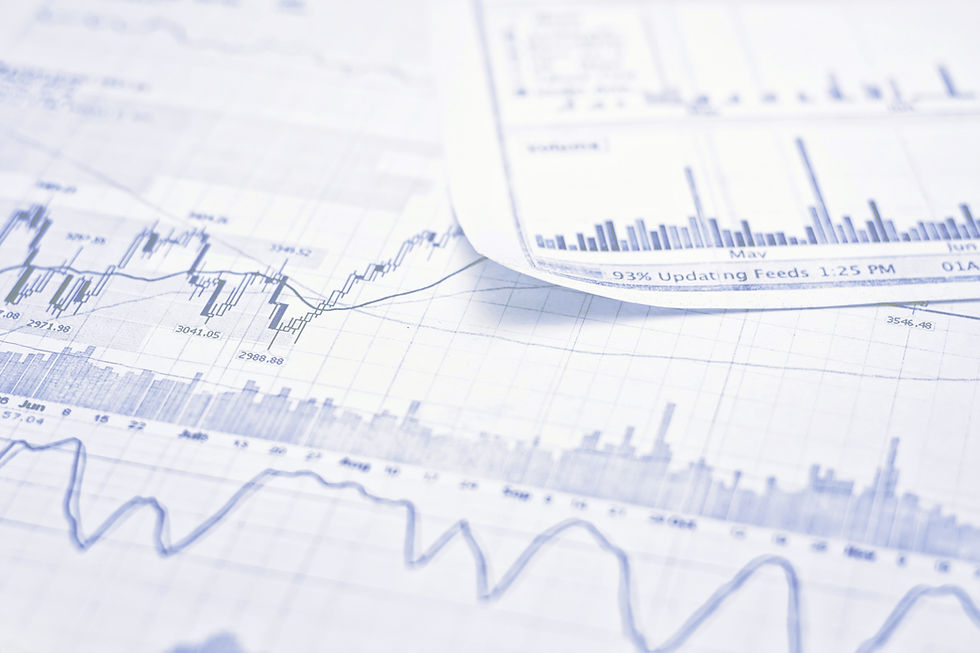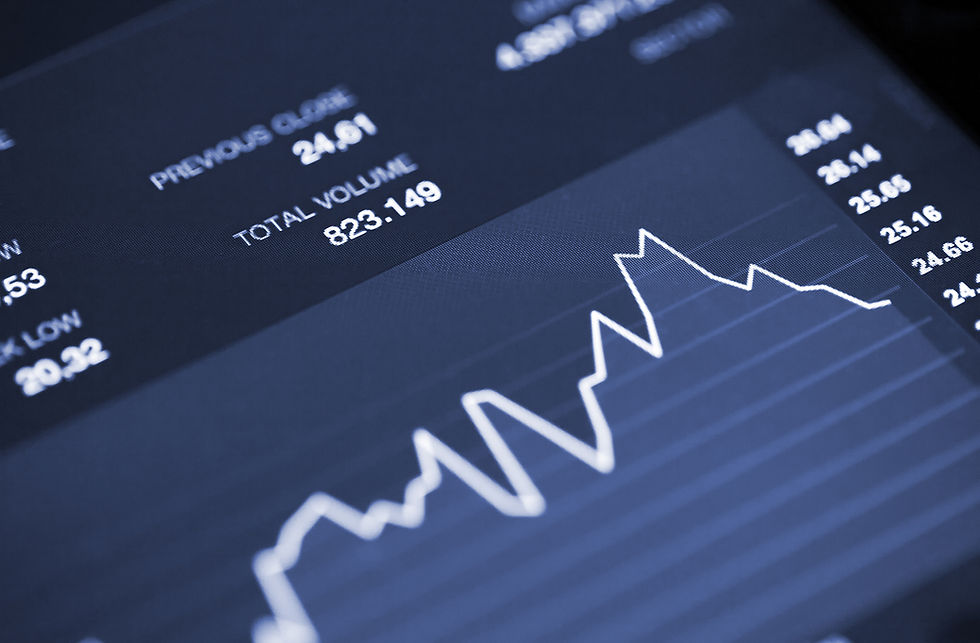Powell: do not rule out the possibility of a rate hike at every FOMC meeting
- rzheng261
- Feb 12, 2022
- 7 min read
On January 27, the Federal Reserve held its January FOMC meeting, which received market attention as investors tried to find policy guidance from the dramatic turmoil in U.S. stocks and global assets over the past period.
The main contents of this meeting are as follows.
First, on QE cuts, the meeting decided that February will still buy $ 20 billion in Treasuries and 10 billion MBS, according to the monthly rate of reduction of $ 30 billion, the current round of QE will end in March.
Second, on interest rate hikes, a strong hint of a March hike was given, in line with expectations, but tending toward the upper edge of expectations on the path of future rate hikes. The meeting did not give a specific path for future tightening, but Powell's post-meeting press conference was hawkish, such as a lot of room for rate hikes without hurting the job market, inflation remains an upside risk, commitment to the policy goal of price stability, the belief that the current job market basically meets the maximum employment target and concerns about wage inflation and low labor force participation, and so on. After these statements, CME interest rate futures are credited with the expectation of four rate hikes for the year.
Third, the future of tapering, the Fed hinted at the beginning soon, but has not yet given a specific path and details, investors expect that the March FOMC meeting will propose a specific path program, the earliest in the June meeting announced the launch.

Unexpectedly hawkish of Powell
Powell reiterated that the decision to keep policy rates unchanged was to support the Fed's two main goals of full employment and long-term inflation of 2%.
Inflation remains "significantly higher" than the long-term inflation target of 2 percent. Bottlenecks and supply chain problems are holding back production, and those factors pushing up inflation are linked to the new pneumonia outbreak. We are wary of the possibility that rising wages could feed through to prices. I believe all the Fed can do is promote economic expansion.
At the same time, he made clear that a large number of factors are supporting a pullback in U.S. inflation. Earlier, Powell said at a hearing this month that inflation remains high because of an imbalance between supply and demand.
The supply side is expected to moderate less quickly than we previously expected. Inflation is expected to fall back in 2022.
Powell, in response to questions from reporters, said the risk of inflation is still on the upside, so the Fed's policy consideration of different economic conditions may produce different results.
The risk is that hyperinflation will persist. What we need is a new round of (economic) long-term expansion. A return to expansion will require prices to remain stable.
The U.S. core CPI in December has reached the highest level in 30 years, the Fed's top officials have previously called to "curb inflation". Last Wednesday, Biden also shouted at the Fed to control rising prices and expressed support for the Fed's independence in formulating monetary policy.
In addition, Powell also said that in 2022, the role of fiscal policy to support economic growth will no longer be so prominent, the ultimate focus is on the real economy. Powell said at the press conference that the U.S. labor market is very strong by many indicators.
The job market has been improving on a broad scale, and the labor force participation rate has increased, but remains depressed. The labor market is "very, very strong" and will likely continue to be so.
Powell also said in a question-and-answer session that the actual outlook for the labor market may be uncertain because of Omicron or other factors, (but we) may have to adapt to such a state of affairs.
Earlier, the Fed said in its last meeting statement, the last condition for a rate hike in March - to achieve "full employment", the meeting showed that the condition has been met, the economic and employment situation is strong, the employment population has steadily increased, the unemployment population has fallen significantly.
Given that inflation is well above 2% and the labor market is strong, the committee expects that an increase in the federal funds target range will soon be appropriate.
On the eve of the meeting, the Wall Street Journal had let slip that Fed officials would keep rates close to zero after the policy meeting, while possibly suggesting they were prepared to raise rates at their next meeting in mid-March.
On the issue of interest rate hikes, which is a common market concern, although the (overall) magnitude of the hike has not yet been decided, Powell said he would not rule out the possibility of a rate hike at every FOMC meeting.
The interest rate dot plot released by the Fed last December showed that Fed officials decided to raise interest rates about three times in 2022, 25 basis points each time, and three and two times in 2023 and 2024, respectively.
Powell said at a news conference that the meeting set guidance for the tapering decision. The reduction of the balance sheet will occur after the start of the rate hike, has not yet made a decision on the timing and speed of tapering, and will be prepared to adjust all the details of the tapering path. The Fed will have several more meetings to discuss the balance sheet reduction, and more details will be discussed at the next meeting.
Powell said, "We do want to reduce the balance sheet by adjusting reinvestment ...... The Fed will meet at least once after the first rate hike to make a decision on the balance sheet."
Powell said in a question and answer session that the Fed has a lot of room to raise interest rates and plans to start raising rates in March, with an undetermined rate hike, not ruling out a rate hike at every rate meeting.
Powell admitted, "We intend to raise interest rates at the March meeting." But no decision has been made on the rate hike. He said that monetary policy needs to be "flexible", taking into account inflation and employment, the U.S. economy no longer needs continued high levels of support. As inflation increases and the labor market is strong, the Fed will continue to adjust it policy.
Powell said the need to move to a "significantly less accommodative policy", the Fed to raise interest rates in support of a very wide range of space to raise interest rates, does not rule out a rate hike at each meeting of the U.S. Federal Open Market Committee.
The three major U.S. stock indexes opened high and then dived sharply during the session collectively, closing with mixed gains and losses. The Dow Jones Industrial Average closed down 0.38%, up more than 1.5% during the day, down more than 900 points during the dive; the S&P 500 fell 0.38%, once up more than 2% during the day; the Nasdaq rose 0.02%, once up 3.42% during the day.
Raise of interest rate

Goldman Sachs economists Jan Hatzius and David Mericle said in a report released over the weekend that they expect the Fed to raise interest rates in March and May and announce the start of balance sheet reduction in June, and then raise rates again in July, September and December, meaning the federal funds rate range is expected to reach 1.25-1.5% by the end of the year.
Before this week's Fed meeting, Goldman Sachs earlier this month had expected the Fed to raise interest rates four times this year, and the balance sheet reduction process will start as early as July.
For the immediate expected increase in the number of rate hikes and taper ahead of schedule, Goldman Sachs economists noted in a report that the bank further raised inflation expectations after the latest data this week, as evidence of U.S. payroll growth above the Fed's inflation target level has strengthened, and in addition, "comments from Fed Chairman Jerome Powell earlier this week clearly indicate that the Fed leadership is open to a more aggressive pace of tightening."
Goldman Sachs said that if market conditions change, or if the economy decelerates much faster than expected and inflation levels remain high, the Fed could still take a tougher-than-expected monetary tightening policy.
The bank also now expects three rate hikes in 2023 and expects the Fed to reach a terminal rate of 2.5%-2.75% in 2024.
Fed Chairman Jerome Powell had said at a press conference after this week's rate meeting that Fed officials were ready to raise rates in March, while not ruling out action at every meeting if more measures are needed to curb inflation, which is climbing at the fastest pace in 40 years.
After the Fed's resolution, several investment banks had previously raised their estimates for the number of Fed rate hikes as early as Goldman Sachs.
The following is a table of Wall Street banks' estimates of the number of Fed rate hikes in the year as of Friday (note: Goldman Sachs estimates have not been updated)
Among them, Bank of America's expectations are certainly the most aggressive, with the bank's strategist Ethan Harris saying in a report to clients on Friday, "We now expect seven rate hikes of 25 basis points each this year, with the federal funds rate peaking at 2.75%-3.00%, which should have a lagging effect on the economy and put growth in 2023 pressure."
In addition, BNP Paribas now expects the Fed to raise rates six times during the year, while the latest forecasts from JPMorgan Chase and Deutsche Bank, among others, are the same as Goldman Sachs' five.
Evercore ISI also raised its benchmark estimate of the number of Fed rate hikes in the year to five on Friday, while saying that as many as seven, as few as three are possible, depending on how the situation develops. Krishna Guha, the agency's head of central bank strategy, noted in a client report, "Our base case scenario now assumes that the Fed will raise rates in March, May and June, announce tapering in July, raise rates in September, stay put in November as inflation cools, and raise rates again in December."
Nomura even expects the Fed's central bank to raise rates by 50 basis points in March, which would be the Fed's largest rate hike since the turn of the century.
U.S. Atlanta Fed President Bostic also said in an interview with British media on Friday that the Fed may extend the (single) rate hike to 50 basis points if inflation remains high. For now, Bostic remains adamant about three rate hikes (25 basis points each) in 2022, with the first hike coming in March, but he also said a more aggressive approach is possible if economic data warrants it.



Kommentit